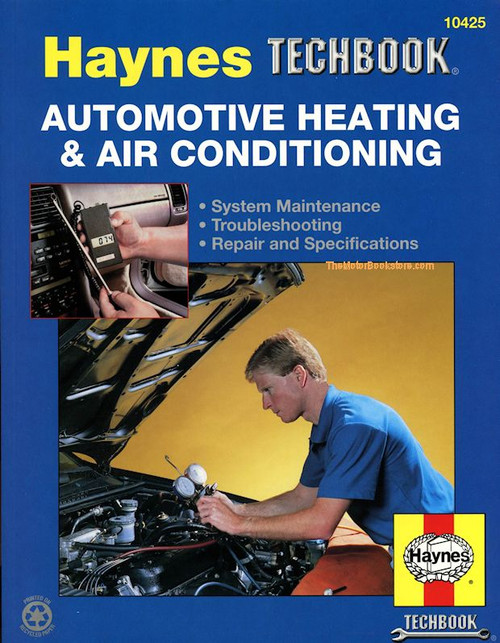The Automotive Electrical Manual by Haynes gives the DIY mechanic all of the information needed to perform electrical repairs on automotive vehicles. The manual includes information necessary to understand basic auto electricity, how to read wiring diagrams, how to properly use electrical test equipment like multimeters, how to perform basic automotive electrical troubleshooting and more. The guide features easy to understand, step-by-step instructions, clear pictures and detailed descriptions to ensure your next electrical repair project is a success. This manual is a must-have book for the serious do-it-yourselfer who's not afraid to do his own electrical repair work at home. The soft-cover book also includes safety tips regarding automotive electricity and details specific tools needed to complete each job. Whether you're a DIY mechanic or an experienced professional brushing up on wiring basics, the Haynes manual is an invaluable resource that no work bench is complete without.
DIAGNOSING AND CORRECTING CIRCUIT FAULTS
Subject: Automotive DIY electrical manual. Basic automotive electricity, troublshooting and repair. ISBN-10: 1850106541 | ISBN-13: 9781850106548 | Haynes 10420
Book Excerpt
UNDERSTANDING WIRING DIAGRAMSWiring diagrams are useful tools when troubleshooting electric circuits. Electrical systems on modern vehicles have become increasingly complex, making a correct diagnosis more difficult. If you take the time to fully understand wiring diagrams, you can take much of the guesswork out of electrical troubleshooting. If you have an older vehicle, you may find the wiring diagrams hard to decipher. Frequently, older diagrams give no information on component location, operation or how to read the diagram. Many of them are organized in ways that make tracing wires difficult. Today's wiring diagrams tend to be more organized, and the cross-references between each portion of the diagram are clearly explained. They often have component locators and some are even in color (to show wire colors).
COMPONENTS OF A WIRING DIAGRAM Wiring diagrams can be broken down into three main components: symbols, color codes and wire gage numbers. SYMBOLS On wiring diagrams, symbols are used to represent the components of the electrical system. The most obvious symbol is a line to represent a wire. Some other symbols are not so obvious, since they do not necessarily look like the components they're representing. That's because most wiring diagram symbols, which are sometimes called schematic symbols, show the way the component functions electrically rather than how it appears physically.
DIAGNOSING AND CORRECTING CIRCUIT FAULTS
CHECKING RESISTANCE Resistance is checked with an ohmmeter. Turn the scale selector switch to the proper ohms range for the device you will be measuring. Make sure the wires are connected to the proper plugs on the meter and turn the meter on. Check that the meter reads "infinity" before testing is begun, then touch the test probes together to ensure the meter goes to zero. Connect one test lead to the positive terminal of the device being tested and connect the other lead to the negative terminal or housing (ground). After testing, switch the ohmmeter off to conserve batteries.
TRACING SHORTS Shorts to grounds are most easily found with a short finder, although a test buzzer is also effective. If you use a buzzer and discover the short is not a component (meaning it is somewhere in the wiring harness), inspect the exposed portions of the wiring harness for obvious evidence of a short (burned wire insulation, chafing, etc). If you still can't find the wiring harness short, we strongly recommend you borrow or purchase a short finder. Finding a hidden short in a wiring harness without this device can be very time consuming.
WITH A SHORT FINDER
- Remove the blown fuse, leaving the battery connected.
- Connect the pulse unit of the short finder across the fuse terminals.
- Close (turn on) all switches in series with the circuit you are troubleshooting.
- Operate the short finder. The short finder will pulse current to the short. This creates a pulsing magnetic field surrounding the circuit wiring between the fuse panel and the short.
- Beginning at the fuse panel, slowly move the short finder meter along the circuit wiring. The meter will show current pulses through the sheet metal and body trim. As long as the meter is between the fuse block and the short, the needle will move with each current pulse.
- When you have moved the meter past the point of the short, the needle will stop moving. Examine the wiring in that area for the short to ground and repair as needed. NOTE: A test light or voltmeter may be substituted for the buzzer. However, an assistant will be needed to watch the light meter while you disconnect components and wiggle the wiring harness.
Subject: Automotive DIY electrical manual. Basic automotive electricity, troublshooting and repair. ISBN-10: 1850106541 | ISBN-13: 9781850106548 | Haynes 10420
TABLE of CONTENTS:
- Preface
- Basic Automotive Electricity
- Measuring Electricity
- Electrical Circuits
- Circuit Malfunctions
- Switches
- Relays and Solenoids
- Circuit Protection
- Understanding Wiring Diagrams
- Reading Wiring Diagrams
- Diagnosing and Correcting Circuit Faults
- Using Test Equipment
- Checking Voltage Drop
- Testing Relays
- General Troubleshooting Strategies
- Making Connections
- Choosing Wire
- Starting Systems
- Starter Motor Design
- Batteries
- Overhauling Starter Motors
- Charging Systems
- Alternators and Generators
- Voltage Regulator
- Lighting Systems
- Light Bulbs
- Headlights
- Installing Auxiliary Lights
- Turn Signals and Hazard Warning Lights
- Brake Lights
- Back-up Lights
- Wiring a Trailer
- Indicator Lights and Gauges
- Accessories
- Cruise Controls
- Heater Blowers
- Electric Rear View Mirrors
- Electric Door Locks
- Power Seats
- Glossary
- ... and much more!










